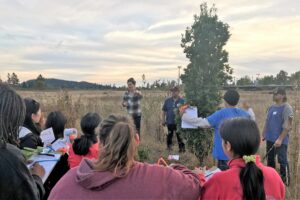Tag: EDI
Build Trust, Make an Impact
Our new EDI & Workforce Training Manager on community relationships
Our Adult Urban Forestry Workforce Training Program is a project with the power to change lives and build community. “It’s one of the more impactful things we’ve done, period,” says Rudy Roquemore, our new EDI & Workforce Training Manager.
Rudy is no stranger to Friends of Trees. He has worked in our Neighborhood Trees program since 2016. Always passionate about issues of equity, diversity and inclusion, he is the perfect fit to step into the role of EDI & Workforce Training Manager.
He brings to the role a philosophy of relationship building that seeks to be more equitable and less transactional. “When we work with an organization, it’s important to make sure we’re aligned in our goals,” Rudy says. “Build trust, then project plan.”
Rudy believes this sort of relationship allows for innovation and growth. We can more readily meet the needs of the organizations we work with, and together, do more thorough work. “The Adult Urban Forestry program has been a tangible way for us to visualize what that pathway can look like,” Rudy says.
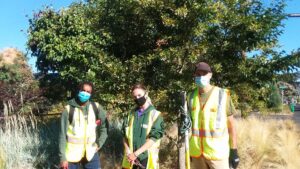
The program enrolls adults in a ten-week urban forestry curriculum and places them in a 100-hour internship with Friends of Trees or an affiliated partner organization. The program, which is designed to engage communities underrepresented in the urban forestry and restoration field, empowers participants to attend by paying them for their time, and creates a pipeline to actual jobs.
“We can make trees relevant to people’s lives,” Rudy says, “by addressing and eliminating barriers to the green workforce. There is a lot of opportunity to grow this program and make a real impact.”
Over the years program partners have included Verde, APANO, Wisdom of the Elders, Rosemary Anderson High School-POIC, Black Parent Initiative, and the Blueprint Foundation. These organizations help select 10-15 program participants each year, who begin with classroom curriculum and field work, and proceed to paid internships.
Tree Care + Equity
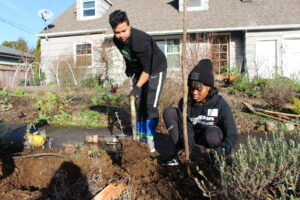 Most people by now are fairly well attuned to the benefits of trees environmentally, socially, mentally, and more. However, less people are aware of how tree canopy is distributed among a city and its neighborhoods.
Most people by now are fairly well attuned to the benefits of trees environmentally, socially, mentally, and more. However, less people are aware of how tree canopy is distributed among a city and its neighborhoods.
A trend across the country in large cities is that trees, and the benefits they bring, are distributed inequitably across neighborhoods based on race and income. Higher income neighborhoods with majority white residents have over 75% tree canopy coverage as compared to lower-income neighborhoods with around 15-30% canopy cover. These are large discrepancies that result in hotter environments, more air pollution, and factors contributing to respiratory conditions like asthma for children.
These trends are reality here in Portland: west Portland (excluding Forest Park) has about 75% canopy cover in most neighborhoods, while east Portland neighborhoods average about 15-30% canopy cover. Friends of Trees prioritizes planting street and yard trees in neighborhoods on the eastside of Portland to help decrease this disparity.
However, many people are wary about – if not outright opposed to – getting a tree of their own because of the costs of tree care, which can increase as a tree grows. This is just one of the reasons Friends of Trees provides tree care along with tree planting, including proper pruning of young trees at no cost to the property owner. And we’re exploring ways to increase the availability of low to no cost tree care for folks who need it, because we know the benefits of trees far outweigh the costs.
In the City of Portland, tree care and maintenance costs are the responsibility of the tree’s adjacent property owner. This is an inequitable financial burden for low-income households, renters, and populations vulnerable to gentrification. Many communities of color cite the financial burdens that a mature tree can bring as a reason to not want to plant trees next to their houses. It’s important to address these very valid concerns since trees have so many benefits, which is why Friends of Trees is continually working on creating programming that is responsive to community needs; in fact, we have funding proposals pending with Portland’s Clean Energy Fund that would help subsidize costs of mature tree care so we can grow our already considerable post-planting tree care services.
Understanding concerns about tree care
In 2018, Friends of Trees partnered with APANO and LARA Media to conduct three focus groups toward better understanding how community members viewed neighborhood trees and tree planting efforts. To increase accessibility these focus groups were conducted in multiple different languages including Vietnamese, Mandarin, and Spanish. Overall, many community members cited the benefits of trees within the city, including their health and environmental benefits:
“Trees are good for the lungs. They are the lungs of the city.”
“In the city, there’s big trees that make the air cooler. It also makes the city greener.”
–participants from the Vietnamese focus group
However, when asked if there are barriers for them to plant trees, many community members cited the long-term costs associated with mature tree care. One participant said: “One of the negatives is that sometimes Portland has a lot of storms and trees fall down when there’s strong wind. I experienced that once. The tree can fall into the house and collapse the house. Usually I try to hire a professional to cut the tree, but it [can cost] thousands of dollars. The tree bothers us.”
Trees and access to the natural environment are integral to healthy, livable neighborhoods. The benefits trees bring are strongest when they are mature, at least 10-15 years after they are planted. However, the fears community members have about the costs trees may bring are also valid, especially since the median household income on the eastside of Portland is lower and there are fears of being pushed out.
Friends of Trees is committed to equitably growing the urban forest through community-centered tree plantings. We offer tree care for the first three years of a tree’s life after it’s planted, including affordable (or free if cost is a prohibiting factor) summer watering service; free mulch; and structural pruning provided at no cost (see the next story for more about our pruning program). Structural pruning on a young tree is vital for its long term health, and can help prevent limbs falling onto a house or car later on in its life, since we can prune for the built environment and the tree will grow into that structure.
However, Friends of Trees also recognizes there are long term costs and concerns that need more support within our communities to make sure the urban forest is distributed equitably. We are continually working on creating programming that is responsive to community needs and when the opportunity arises we pursue grant funding to help subsidize costs of mature tree care. Because we know that, all in all, the positives of trees far outweigh the negatives; as our good friends at J Frank Schmidt like to say, “Trees are the answer.”
Photo: Street tree planting in east Portland, January 2020.
Connecting Black urban youth to the environment
Meet The Blueprint Foundation
“I like the feeling of getting my hands dirty because I feel like I did something. It’s a good feeling.”
Lashay, Friends of Trees intern through the Blueprint Foundation
Friends of Trees is fortunate to have relationships with quite a few local nonprofit organizations that benefit under-served communities, such as communities of color, at-risk youth, and neighborhoods with very little tree canopy. These partnerships help make trees accessible to community members who may not otherwise have access to all that trees do for us.
The Blueprint Foundation works to expose Black urban youth to learning opportunities they usually do not get to access. Friends of Trees is proud to be a partner to the Blueprint Foundation’s Grounding Waters program, where students learn about careers in environmental science while taking an active role in environmental stewardship.
“One of the first and most consistent activities we’ve had our kids do is the Friends of Trees neighborhood plantings, which allows them to connect with their neighbors, as well as do something directly beneficial to their own community, that they see, that has permanence.” – Jason Stroman, Program Director, The Blueprint Foundation; Friends of Trees Board of Directors
The Friends of Trees – Blueprint Foundation partnership introduces Black youth to jobs in the urban forestry field. Students receive stipends to gain job and leadership skills through training and participating with Friends of Trees as Summer Tree Inspectors and tree planting Crew Leaders.
The Blueprint-Friends of Trees partnership helps connect young people to the environment, while also supporting a historically underrepresented community’s access to nature and its benefits by decreasing barriers to participation. “The ultimate goal,” Jason points out, “is to eliminate the opportunity gap that we see for Black youth.”
Get to Know our pruning program – 2,000 trees pruned this season!
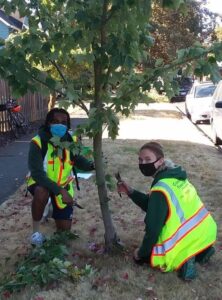
Pruning trees contributes to a more equitable community. Or, more accurately, pruning trees at no cost contributes to a more equitable, livable community.
How? We’ve learned that a major barrier to many households getting a street tree is the cost of maintaining the tree. Pruning can be very expensive, and it gets more expensive as the tree ages and grows if problems are not addressed early. Properly pruning a tree when young is an excellent investment and can delay or even prevent future expenses, making a tree more affordable. Pruning young trees at no cost by trained Friends of Trees volunteers is one important way to help get more trees into more neighborhoods, especially under-served, low-income communities which are often communities of color impacted by systemic disparities. That is exactly why Friends of Trees is focusing efforts on specifically those communities who will benefit the most.
Our pruning program also benefits youth through our educational partnerships. While we are pruning trees we are also training young people to prune. Through partnerships with organizations like Rosemary Anderson HS POIC, student interns in our pruning program earn an hourly stipend while building valuable job skills. Pruning skills can be developed and honed in preparation for becoming an ISA-certified arborist – a very solid living with excellent job security. Added bonus: Exposing young people to the benefits of trees and tree care contributes to a greater appreciation of trees and nature, helping to grow the next generation’s Tree Team.
Pruning = longer lived, healthier trees = healthier planet + people. The benefits of trees—oxygen creation, pollution and stormwater absorption, healthier humans (DYK that trees help combat cardiac and respiratory ailments and can even contribute to increased birthweights?), and so much more—increase exponentially as trees grow and age. And the earlier a tree is properly pruned, the greater the chance it will grow to a ripe old age benefitting neighborhoods and the planet for generations to come.
Pruning for structure (shape) and clearance (sidewalks and streets) is the primary way to steward and care for a tree post-establishment. Proper pruning contributes to the long-term health of the tree, while lack of pruning, or pruning incorrectly, will contribute to the premature demise of the tree. Pruning in the built environment (as opposed to a natural setting) is also key to preventing tree-related damage following inclement weather.
There’s another reason pruning young trees is better: It’s easier for the tree to recover from pruning when it’s young than it is when the tree is more mature (trees have to “recover” after any sort of pruning, good or bad, it’s just far more efficient for them to recover from careful “surgery” by a trained pruner as opposed to “natural” pruning by snow/ice + wind). When pruned, a tree immediately gets to work “sealing” the cut, working to close off the wound.
When pruning young trees, we have the opportunity to make a 5-cent cut today to prevent the need for a $100 cut 20 years down the road (or, so the saying kind of goes ;). Not only is it more cost-effective to properly prune young trees, the larger the pruning cut (because the limbs are larger), the longer it takes the tree to recover. A tree can quickly seal and move beyond a ¼” cut made with hand pruners, but it may takes years to recover from an 8” diameter cut made with a chainsaw (and it may never recover at all). BTW, trees don’t actually “heal,” they seal or compartmentalize and – once recovered – they then grow more vigorously.
With all the benefits of pruning it’s a good thing our pruning program is so popular with volunteers (100+ pruning volunteers every year!), since volunteer-power is the only way we’ll be able to prune 2,000 trees this season. Pruning is especially popular right now as it’s pretty pandemic-resistant: pruning is not a large group activity and it takes place 100% outdoors. In fact, it’s because of COVID that this will be the biggest pruning season yet, with a 40% increase in trees pruned over last season! BTW, we’ll prune any young street tree in our service area (6” diameter or smaller), not just the trees we plant – all at no cost (thanks in large part to our partners at City of Portland Bureau of Environmental Services).
Pruning trees properly contributes to the health of the tree and to those who live under its canopy. We of course want the trees we plant to grow and thrive, and proper pruning when young is key to tree health, so pruning is an important part of our Neighborhood Trees program. Need more information? Visit our tree resources page for more information about tree care and the benefits of trees. Ready for a tree of your own? Get started here!
Photo: Youth interns learning to prune, part of our Rosemary Anderson High School/POIC partnership; August 2020.
Friends of Trees stands with our Black colleagues, partners, and community members
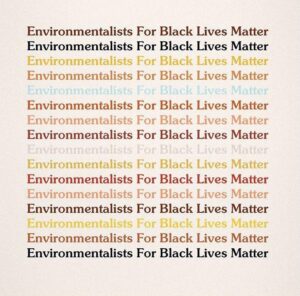
If you have come here to help me, you are wasting your time. But if you have come because your liberation is bound up with mine, then let us work together. -Lilla Watson
Friends,
Friends of Trees is incensed and stands in solidarity with the Black community. We add our voice to the many groups and institutions this week calling for justice for George Floyd, Breonna Taylor, Tony McDade, Ahmaud Aubrey, and too many others.
It is undisputed that Black, Indigenous, and all people of color bear a disproportionate impact of racial injustice and its deadly consequences. Environmental justice is among these systemic inequalities. FOT acknowledges that the Black community is more impacted by respiratory illnesses due to poor air quality making them more vulnerable. At Friends of Trees, we believe the benefits of trees should be experienced by everyone: clean air, clean water, and healthy communities are human rights. We heartily commit to listening to community needs as we work for an environmentally just future where Black folks can breathe freely.
Just as trees are connected via their root systems and intertwine underground with fungi to exchange nutrients, carbon, and water in order to survive and thrive, so too are our human communities connected. When white supremacy and police brutality affect some, it is a blight on us all. Just like a tree community’s root systems, the onus is on those with resources to combat the disease.
Friends of Trees is responding to the call for action and encourages you to join. Each and every one of us can use our voices to support the Black community. We urge you to get involved.
Onward,
Whitney Dorer, Interim Executive Director
Phoebe Krueger, Board Chair
Environmentalists For Black Lives Matter image by @greengirlleah
Get involved:
The Blueprint Foundation | The Black Parent Initiative | Black Lives Matter: PDX | Imagine Black | Equitable Giving Circle | The Black Resilience Fund | NAACP Portland | Eugene Springfield NAACP | Urban League of Portland | Coalition of Communities of Color | Momentum Alliance | Self Enhancement, Inc. | Campaign Zero | Don’t Shoot Portland | Black United Fund of Oregon

